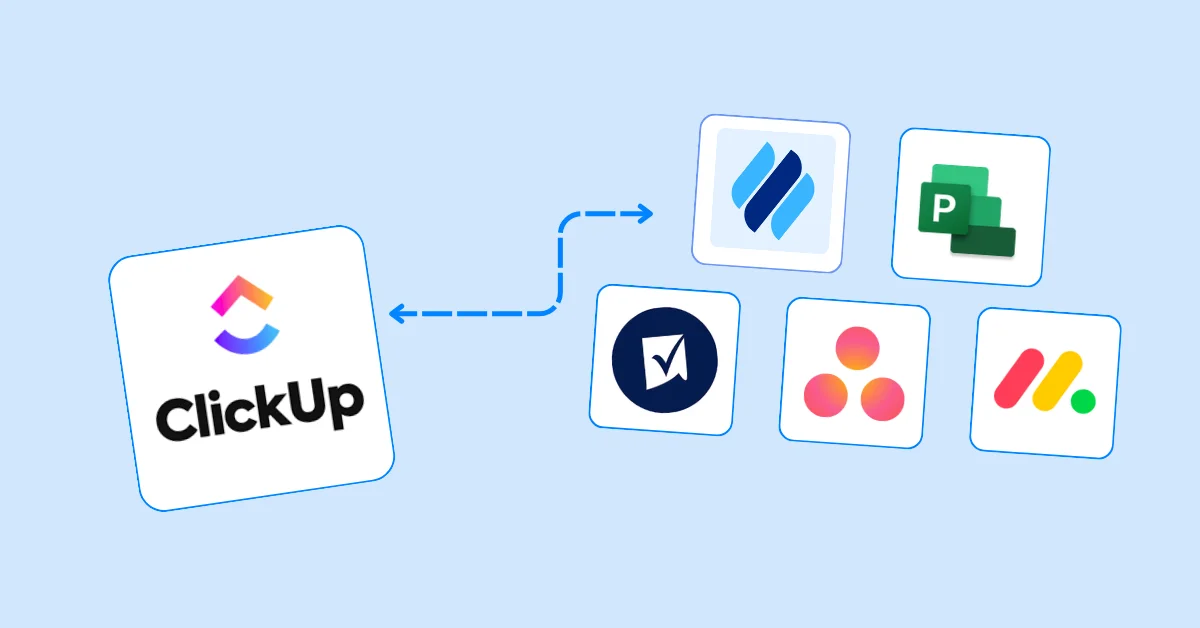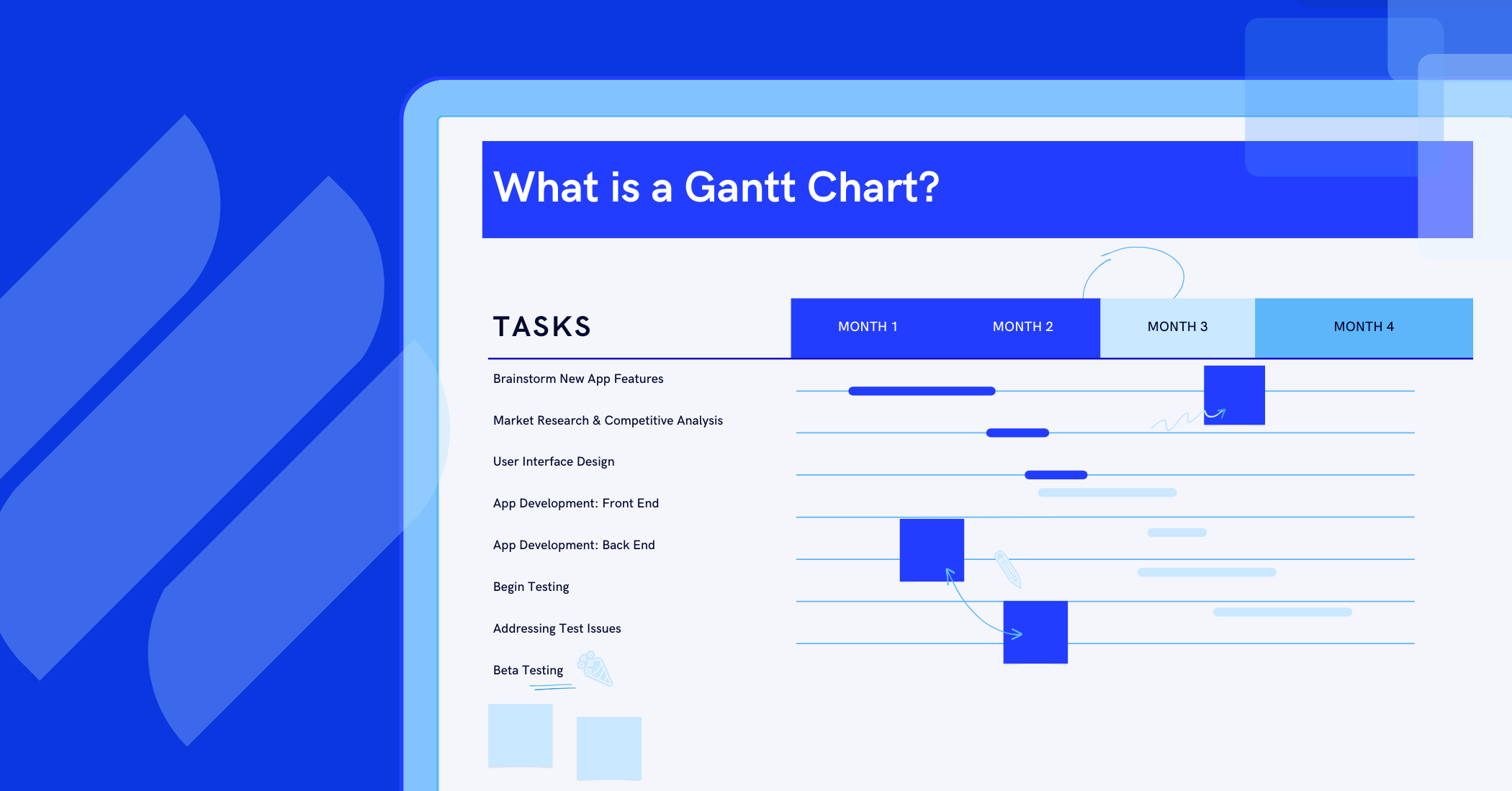Project Governance for Large-Scale and Complex Projects
Learn how project governance ensures clarity, accountability, and success in managing large-scale and complex projects.
Large-scale and complex projects can feel like navigating a maze with countless moving parts like multiple teams, hefty budgets, tight deadlines, and high stakes. Without a clear framework, even the most promising initiatives risk derailment. This is where project governance steps in as the guiding force, ensuring clarity, accountability, and success.
In this blog, we’ll dive into what project governance entails, how it differs from project management, its critical role in large-scale endeavors, and actionable steps to implement it effectively. With practical insights and actionable strategies, you’ll learn how to steer your ambitious projects to victory.
What is Project Governance?
Project governance is the structured framework that defines how a project is managed, from decision-making to accountability. It’s the rulebook that outlines processes, roles, responsibilities, and policies to keep everyone aligned. For large-scale projects like building a corporate headquarters, launching a global product, or rolling out enterprise software, governance is the glue that holds everything together.
Why Project Governance Matters
Large-scale projects involve multiple stakeholders, significant resources, and intricate timelines. Without governance, risks like miscommunication, scope creep, or resource mismanagement can spiral. The 2024 PMI Pulse of the Profession report highlights that 94% of highly agile organizations have a formal governance body, such as a Project Management Office (PMO), which contributes to better project performance. This shows governance’s direct impact on success. Project governance delivers:
- Strategic Alignment: Links project goals to the organization’s big-picture objectives.
- Accountability: Clarifies who’s responsible for what, reducing confusion.
- Risk Mitigation: Identifies and addresses potential issues early.
- Efficient Decision-Making: Ensures decisions are timely and made by the right people.
- Resource Optimization: Allocates time, money, and talent effectively.
By addressing these areas, governance transforms chaotic projects into well-oiled machines.
Project Governance vs. Project Management
While project governance and project management are closely related, they serve distinct purposes. Understanding their differences is key to leveraging both effectively in large-scale projects.
(Learn more: What is Project Management)
Key Differences
- Project Governance: Focuses on the strategic oversight of a project, setting the framework for how it’s directed and controlled. It answers “what” and “why,” ensuring alignment with organizational goals, clear decision-making processes, and accountability.
- Project Management: Centers on the execution of the project, handling day-to-day operations to deliver results. It answers “how” and “when,” focusing on tasks, timelines, and resource coordination.
Think of governance as the architect designing the blueprint and management as the builder bringing it to life. Governance provides the rules, while management follows them to achieve objectives.
Comparison Table: Project Governance vs. Project Management
| Aspect | Project Governance | Project Management |
|---|---|---|
| Focus | Strategic oversight, direction, and alignment with organizational goals. | Tactical execution, task coordination, and delivery of project outcomes. |
| Scope | Defines the framework, policies, and decision-making processes. | Manages tasks, schedules, budgets, and resources within the governance framework. |
| Key Responsibilities | Sets roles, establishes KPIs, ensures accountability, and mitigates risks. | Plans, tracks, and executes tasks, ensuring deliverables meet quality and time goals. |
| Primary Questions | What are we doing? Why are we doing it? Who makes decisions? | How do we do it? When will it be done? Who does what tasks? |
| Key Deliverables | Project charter, governance plan, risk registers, decision-making protocols. | Project plans, schedules, budgets, status reports, and completed deliverables. |
| Stakeholder Involvement | Engages senior stakeholders (e.g., sponsors, steering committees) for oversight. | Engages operational teams and stakeholders for task execution and coordination. |
| Example in Action | A steering committee approves a budget increase for a global product launch. | A project manager assigns tasks to ensure the product launch meets its deadline. |
Why Both Matter
In large-scale projects, governance and management are complementary. Governance ensures the project stays aligned with strategic goals, while management drives the day-to-day progress. For example, in a multinational software rollout, governance might define compliance requirements, while management ensures the IT team meets those standards on schedule. Together, they create a robust system for success.
Core Components of Project Governance
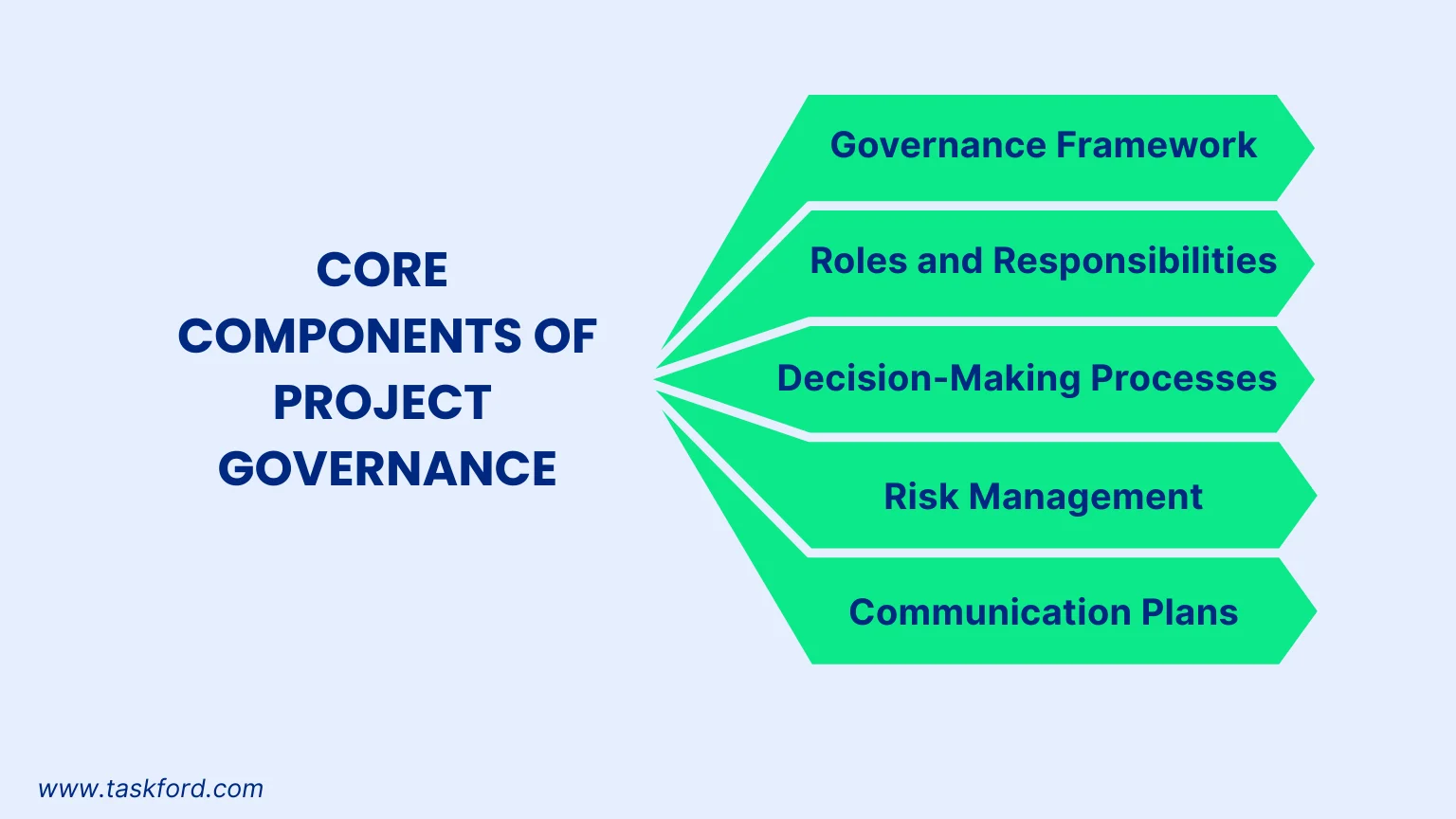
Effective project governance hinges on five key components. Let’s break them down:
1. Governance Framework
The foundation of governance is a clear framework that includes:
- Project Charter: Defines the project’s purpose, scope, and objectives.
- Governance Plan: Details decision-making processes, reporting structures, and escalation paths.
- Performance Metrics: Tracks progress with KPIs like budget adherence or milestone completion.
For example, a multinational infrastructure project might need a framework that accounts for local regulations and stakeholder diversity.
2. Roles and Responsibilities
Clear roles prevent overlap and confusion. Common roles include:
- Project Sponsor: Secures funding and provides strategic oversight.
- Project Manager: Handles daily operations and team coordination.
(Learn more: What Does A Project Manager Do?)
- Steering Committee: Makes high-level decisions and resolves conflicts.
- Project Team: Executes tasks, from engineers to analysts.
In a software implementation, the project manager might oversee technical teams, while the steering committee approves budget changes.
3. Decision-Making Processes
Large projects demand clear decision-making protocols to avoid delays. This includes:
- Decision Rights: Who approves budgets or scope changes?
- Escalation Paths: How are issues escalated when they exceed authority?
- Approval Processes: How are decisions documented and shared?
For instance, in a construction project, minor schedule tweaks might be approved by the project manager, but budget overruns go to the steering committee.
4. Risk Management
Complex projects are inherently risky. Governance includes:
- Risk Registers: Logs potential risks, their likelihood, and impact.
- Mitigation Plans: Strategies like contingency budgets or backup timelines.
- Regular Reviews: Ongoing assessments to stay proactive.
A global supply chain project might track risks like geopolitical issues or supplier delays.
5. Communication Plans
Communication is the lifeline of large projects. Governance defines:
- Reporting Structures: Weekly status reports or monthly executive updates.
- Stakeholder Engagement: Town halls or dashboards to keep everyone aligned.
- Feedback Loops: Channels for teams to raise concerns or ideas.
A healthcare system rollout might use dashboards to keep clinicians, IT, and executives on the same page.
How to Implement Project Governance
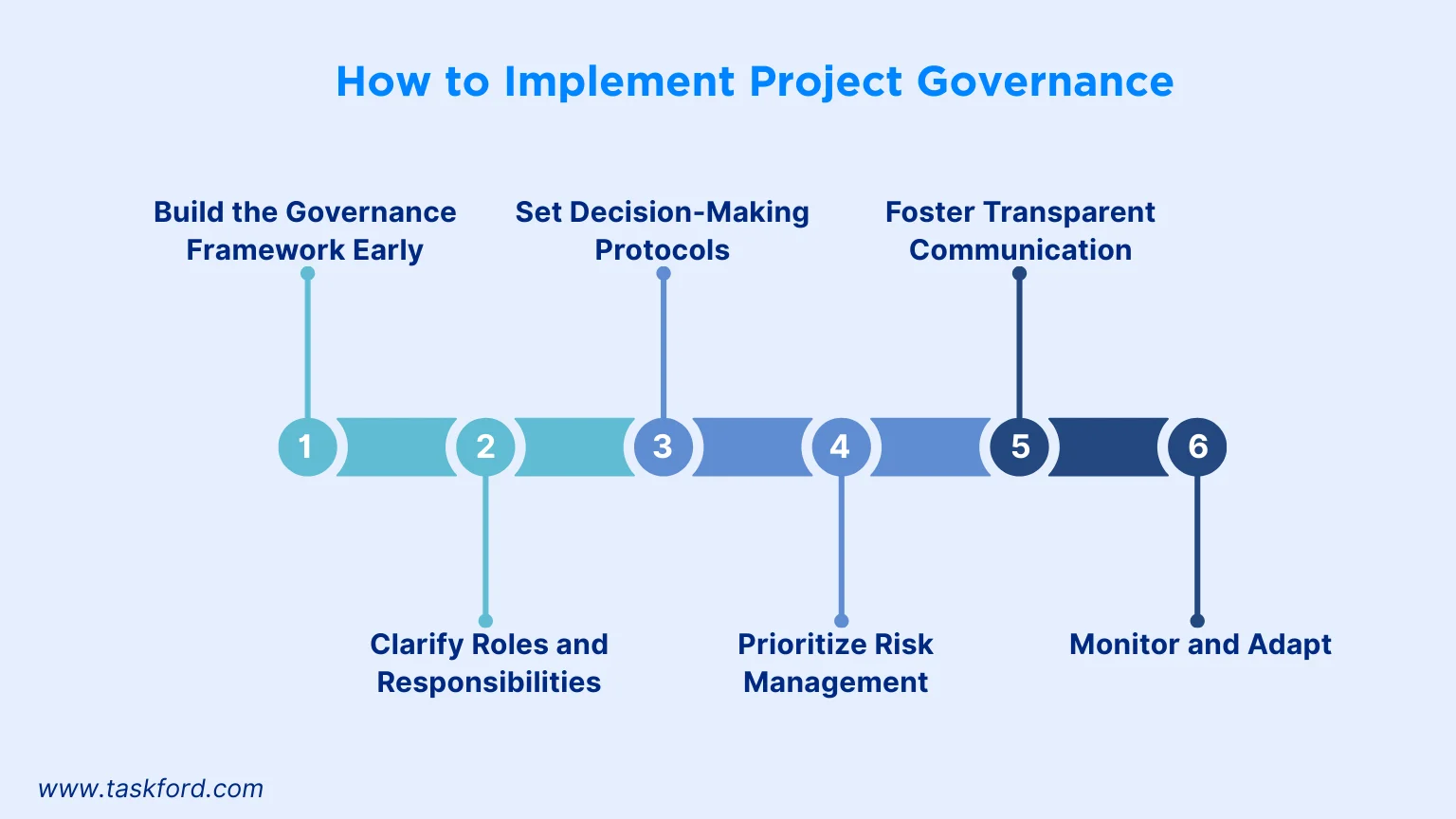
Ready to put governance into action? Follow these steps tailored for large-scale project management:
Step 1: Build the Governance Framework Early
Start during the project’s initiation phase. Involve key stakeholders to ensure alignment and buy-in. For a government infrastructure project, this might mean consulting public officials and contractors. Include:
- A project charter with clear objectives and scope.
- A governance plan outlining processes and roles.
- KPIs to measure success, like on-time delivery.
Step 2: Clarify Roles and Responsibilities
Use a RACI matrix (Responsible, Accountable, Consulted, Informed) to define roles. For an IT project, the project manager might assign tasks, while the CIO oversees strategy. Reinforce roles through onboarding and regular check-ins.
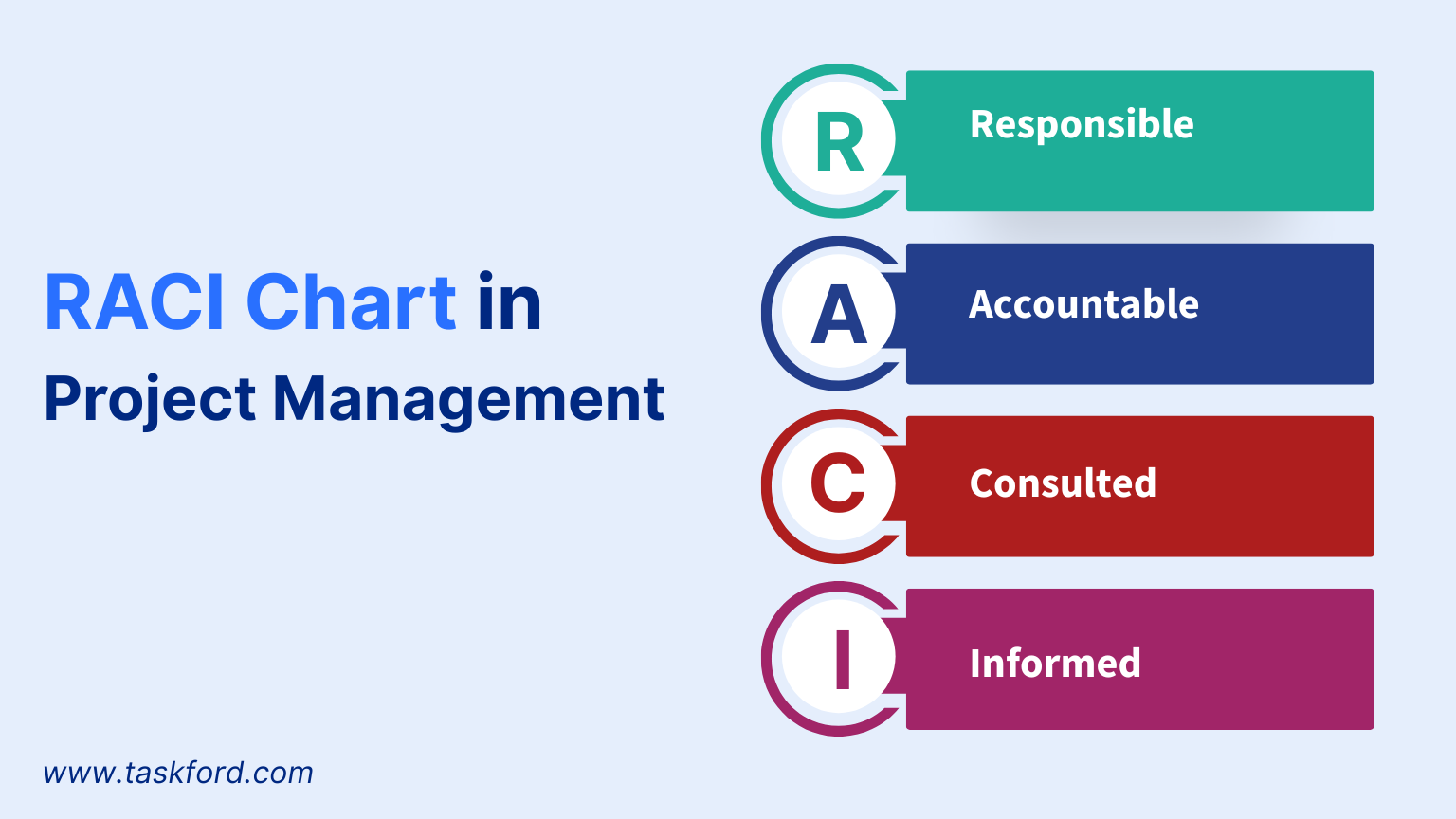
(Learn more: RACI Chart in Project Management)
Step 3: Set Decision-Making Protocols
Create a hierarchy that balances speed and oversight. For a global marketing campaign, regional teams might handle local decisions, but budget changes need global approval. Document decisions in tools like TaskFord for transparency.
Step 4: Prioritize Risk Management
Conduct a risk assessment early to identify issues like regulatory hurdles or supply chain disruptions. Develop mitigation plans and assign owners. For a pharmaceutical project, regular audits might ensure FDA compliance.
Step 5: Foster Transparent Communication
Define how information flows. Specify:
- Update frequency (e.g., weekly team meetings).
- Tools (e.g., project management software).
- Escalation processes for conflicts.
In a multi-site construction project, daily reports and weekly virtual meetings keep teams aligned.
Step 6: Monitor and Adapt
Governance isn’t set in stone. Review the framework regularly to adjust KPIs, roles, or risks as needed. For a tech rollout, onboarding new vendors might require governance updates. Use data from project management tools to guide adjustments.
Overcoming Common Governance Challenges
Even the best governance plans face hurdles. Here’s how to tackle them:
- Stakeholder Misalignment: Diverse stakeholders often have competing priorities. Engage them early, set shared goals, and maintain open communication through regular updates or meetings.
- Scope Creep: New requirements can derail projects. Use a change management process to evaluate and approve scope changes. For a software project, new features might need steering committee approval.
- Resource Constraints: Large projects strain resources. Governance prioritizes allocation based on project needs. Track usage with project management tools to stay on course.
- Resistance to Governance: Some teams see governance as red tape. Highlight its benefits like clarity and accountability and involve teams in shaping the framework to build ownership.
The Role of Technology in Governance
A comprehensive project management and resource planning platform like TaskFord can supercharge project governance by offering:
- Real-Time Reporting: Track time, tasks, resources and share updates instantly.
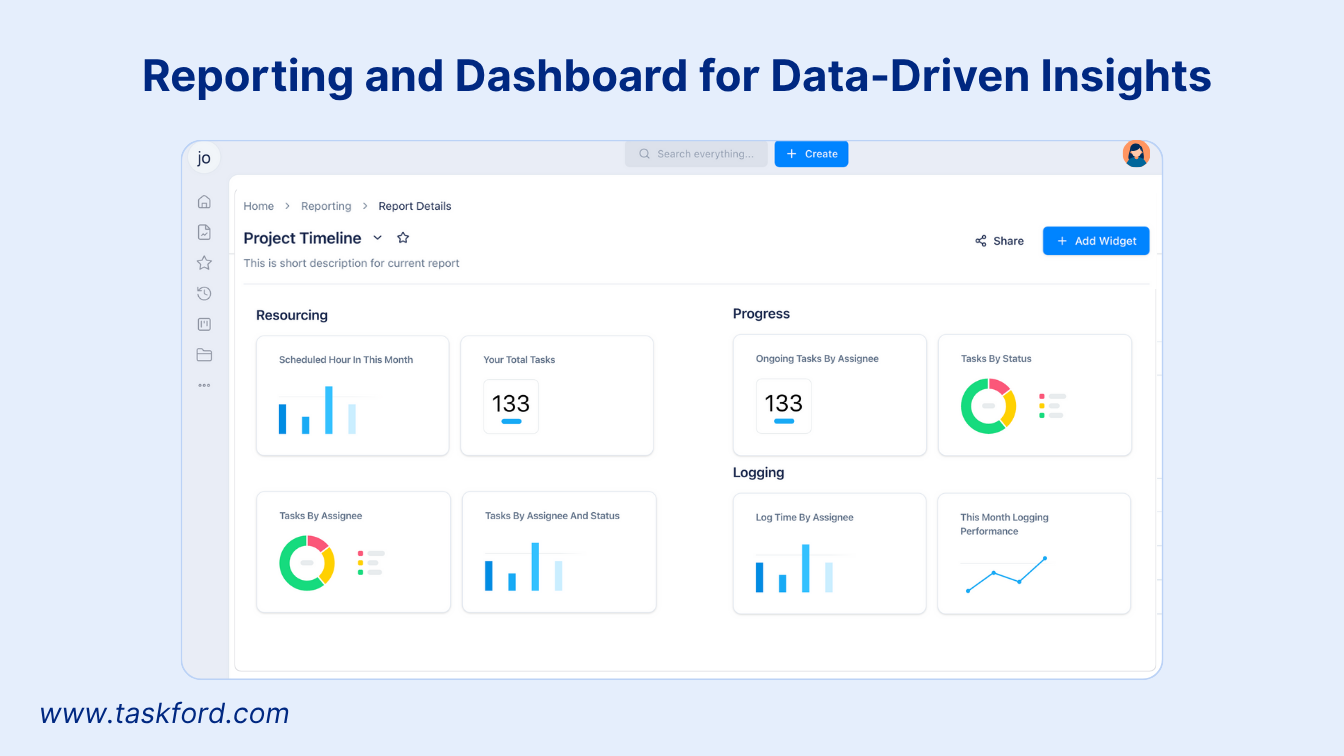
- Collaboration: Connect distributed teams.
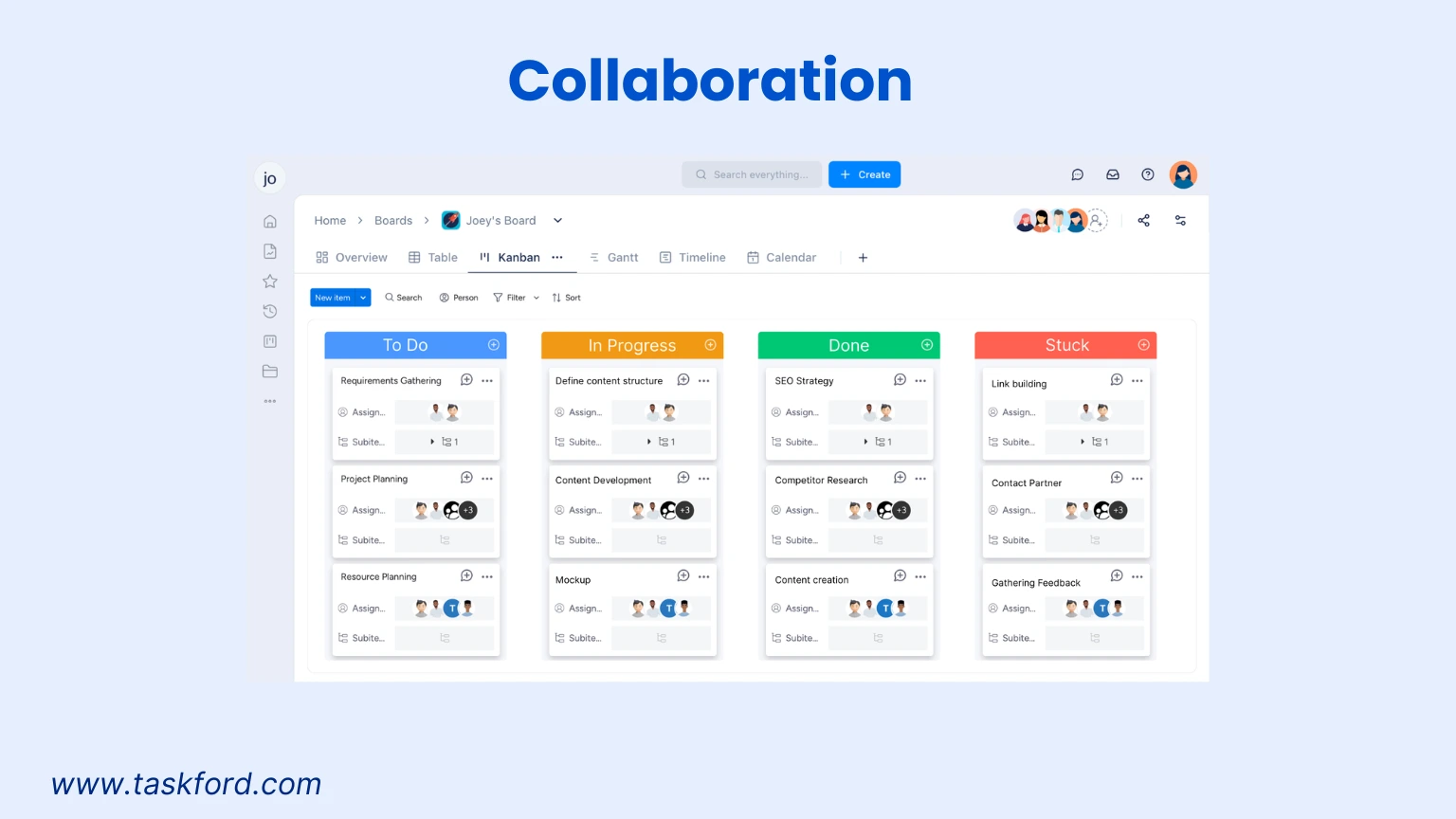
- Data Insights: Use analytics to monitor progress and risks.
TaskFord, for instance, lets teams create custom dashboards, track milestones, and manage risks, making governance more transparent and effective.
Case Study: Governance in a Global Product Launch
Imagine a multinational corporation launching a product across 20 countries with a $50 million budget and a 12-month timeline. Here’s how governance ensures success:
- Framework: A project charter aligns teams on the launch goal. A governance plan details processes and reporting.
- Roles: A global project manager oversees operations, regional leads handle local execution, and a steering committee approves major decisions.
- Decision-Making: Regional teams adjust campaigns, but budget changes need committee approval.
- Risk Management: A risk register tracks issues like supply chain delays, with mitigation plans in place.
- Communication: Weekly reports and a shared dashboard keep stakeholders informed.
The result? An on-time, on-budget launch that meets regulatory requirements, showcasing governance’s power.
Conclusion
Project governance is the linchpin of successful project management for large-scale and complex initiatives. By defining clear frameworks, roles, and processes, it ensures alignment, accountability, and risk mitigation. Whether you’re managing a global product launch or a major infrastructure project, governance turns complexity into opportunity.
Ready to elevate your project management? Explore TaskFord to implement robust governance and drive your projects to success.
Learn more
- 80 Key Project Management Terms You Should Know
- The Power of Hybrid Methodology: When Agile Meets Waterfall
- Triple Constraints of Project Management: Time, Scope & Cost
Making work simpler,
smarter, and more connected
Join our waitlist and be notified first.

Related Blog
Subscribe for Expert Tips
Unlock expert insights and stay ahead with TaskFord. Sign up now to receive valuable tips, strategies, and updates directly in your inbox.



